Website navigation


A Modern Perspective: Shakespeare's Sonnets
By Lynne Magnusson
In the movie Shakespeare in Love, it is a conventionally beautiful woman of high social status and at least respectable morality who fires up Will Shakespeare’s desire. If the filmmakers were taking their cues for a script about Shakespeare’s passions from the Sonnets, one might have expected a less orthodox story. Most of the first 126 sonnets—if we can trust that the order in which the 154 sonnets were published in 1609 represents a planned sequence—evoke a poet’s highly charged desire for a beautiful young man of high status. He is the one praised in Sonnet 18 ’s “Shall I compare thee to a summer’s day?,” the famous romantic tribute that Will in the movie addresses to his lady. For the sonnet speaker, the fair young man is what grounds his idealizing imagination and his lyrical poetry, the trigger for complex emotions, and the object of sexual desire. The young man’s face may be like a beautiful woman’s, leading the poet to call him “the master mistress of my passion” (s. 20.2 ), but what is special in this relationship is between men. The reception of the sonnets has been colored by strategies for denying or downplaying this basic situation, allowing readers of scattered anthologized sonnets—like moviegoers—to slip very easily into the unchallenged assumption that the addressee to whom the speaker says “I love you so” (s. 71.6 ) is a woman like the fair and remote “she” of Petrarchan sonnet convention. Thus, before we come to the necessary qualifications about the sketchiness of the sonnet story, it is important to be explicit about the primary relationship. Shakespeare transforms the conventional sonnet story by making his beloved a “he.”
There is also a female lover in the sonnets, the focus of a secondary relationship treated in many of the last twenty-eight sonnets ( 127 –54). But when attention turns to her, it is not to assert the normality of heterosexual romance. Things have gone downhill for the speaker, into an obsessive cycle of longing and loathing. By the conventional standards of the Petrarchan sonnet tradition, the woman in question lacks beauty and sexual virtue. Regularly referred to by sonnet readers as the “dark lady,” she is described in the famous anti-Petrarchan poem “My mistress’ eyes are nothing like the sun” (s. 130 ). It affords her ironic praise by inverting and undermining unrealistic sonnet compliments. The speaker’s passion for the dark lady, set in contrast to his love for the fair young man, grounds his discourse in lies and equivocation, triggers out-of-control emotions and self-loathing, and tangles him in insatiable and shameful lust. The speaker deploys a playful satiric cleverness in some of these poems, as if to detach himself from strong emotions, but the savage self-loathing precipitated by dependence on this woman and even hints of misogyny break out. The speaker compares the dark lady’s apparently promiscuous sexuality to a “bay where all men ride” (s. 137.6 ), and his punning imagination fantasizes a situation with his “will,” or sexual member, only one among others filling her “full with wills” (s. 136.6 ). To top it all off, he turns the virtuosity of his poetic skill to excusing the ultimate degradation of the dark lady’s sexual affair with his own male beloved.
Insofar as the sonnet sequence tells a story of passion, this sketch sets out some of its basic coordinates. Yet whether the sonnets are telling any story that bears on Shakespeare’s life—or, indeed, any consistent story with a clear cast of characters at all—is a contentious issue. Are the sonnets in any sense a record of events, evoking autobiographical reference or, more generally, particular sociohistorical contexts? Or are they exquisitely self-contained poems, to be valued primarily for their artistic play of words? Admirers of Shakespeare’s Sonnets have tended to choose one approach or the other, often in an all-or-nothing way. This essay will argue for a middle course by suggesting how Shakespeare’s verbal artistry is embedded in historical contexts. But let’s first look briefly at the problems with the standoff.
Those seeking Shakespearean life events have cried “eureka” over identifications of the young man sparked by publisher Thomas Thorpe’s inscription in the 1609 edition to a “Mr. W.H.” Some, insisting the initials became somehow reversed, identify the young man as Henry Wriothesley, earl of Southampton, who was one of Shakespeare’s earliest known patrons; others opt for another known patron, William Herbert, earl of Pembroke. Still others, adding cues from Shakespeare’s wordplay, argue that puns on “will” and “hues” point to a Willie Hughes. 1 Scholars seeking to persuade readers of their various identifications of the mistress with, for example, an Elizabethan lady-in-waiting (Mary Fitton), a female poet (Emilia Lanier), or a London prostitute (Luce Negro), usually isolate the Sonnets’ somewhat elusive characterization of her in terms of “blackness.” 2 With varying interpretive ingenuity, they seek to apply this ideologically loaded descriptor to their candidate’s eyes, deeds, hair, character, or complexion.
There are problems with reading the sonnets in this way. To begin with, there is simply too little information about Shakespeare’s life on which to build arguments about his personal relationships or their intensity. Furthermore, reading to this end does little to open up the accomplishment of the sonnets: active interpretation of these complex and original poems is sacrificed to a narrow search for evidence. Finally, even if the poems were partly inspired by particular relations and circumstances, these are mediated by the sonnets’ interplay with literary traditions and poetic intertexts. Shakespeare’s choice of a male beloved is itself a good example, for what it signifies is closely tied to its surprising innovation on Petrarchan convention.
In the other camp, astute critics of lyric poetry such as Helen Vendler and Stephen Booth press readers to attend to the “sonnets as poems,” not primarily because information about Shakespeare’s life is scarce but because of their conviction about how poetic language works. In Vendler’s view, the “true ‘actors’ in lyric are words,” and the event or “drama of any lyric” has to do with innovations in words or “new stylistic arrangements.” 3 It is undoubtedly true that the richest pleasures of the individual sonnets are to be gained through active reading. Such a reading process might profitably attend to the overall sonnet structure—to how the shape of the sentences and the trajectory of the thought cohere with or pull against the three quatrains and final couplet of the Shakespearean form. At a more detailed level, the reading might focus on rhetorical figures of speech. Part of the pleasure of a Shakespearean sonnet comes in recognizing its rhetorical play, both where repetitions of words and sounds (e.g., alliteration, assonance) make for rich resonances and where metaphor and wordplay trigger unexpected meanings in words.
Nonetheless, most readers would not accept that words are the only actors. The poems excite curiosity about the speaker’s situation, and they powerfully express his emotions and private consciousness. If the lyric refers to or mimes anything outside the realm of words, Vendler claims, it is delimited to “the performance of mind in solitary speech.” In her view, lyrical poetry typically “strips away most social specification (age, regional location, sex, class, even race),” so that the speaking “I” is “voiceable by anyone.” 4 My contention is that to deny the relevance of social context is to misunderstand much of the innovation of Shakespeare’s language. These sonnets are not the unaddressed speeches of an anonymous “I.” They are utterances in which it matters who is speaking, to whom, and in what situation.
Shakespeare’s use of pronouns gives a strong cue that direction of address and situational specifics matter. In other major sonnet sequences of his time, after the first-person pronoun “I,” the third-person pronoun (i.e., “she,” “her,” or “him”) occurs with greatest frequency. In Shakespeare, it is the second person of direct address, the “thou” or “you,” and these pronouns occur almost as frequently as the speaking “I.” 5 Shakespeare’s speaker is not analyzing his inner experience in relation to the loved object, the “she” of most other Elizabethan sequences. Instead, the poems work like conversation, even if they get no direct answer. Most Shakespeare sonnets are less the isolated expression of an “I” than a social dialogue, albeit with only one speaker. As with any conversation or phone call overheard, they make a demand on the interpreter to imagine who would say this to whom, and in what situation. Speech is a social activity: what one says depends on whom one speaks to and in what context. Shakespeare, a dramatist turning his hand to lyric, innovates by creating the private thought of his speaker out of the materials of socially situated conversation. We as readers cannot come to know this “I” without making an active effort to figure out the context and follow the conversation. The rest of this essay will take a look at the opening movement of the sonnets as a changing “dialogue of one.” 6
Changing the Conversation
While the Sonnets as a whole are famous for giving a new intonation to inward feeling and private thought, the focus is not on the speaker’s “I” from the outset. The sequence begins with seventeen sonnets often referred to as the procreation group. They advise a beautiful young man to marry and procreate so that his beauty will be replicated and preserved in his children against time’s ruinous process of decay: “From fairest creatures we desire increase, / That thereby beauty’s rose might never die” (s. 1.1 –2). Who would speak this way, and in what situation? It is true that a conventional Petrarchan sonnet lover might use metaphors like “beauty’s rose,” but this speaker adopts a surprisingly public and authoritative stance. A first cue is the choice of “we” over “I,” as if he is speaking for a larger group. In the first line, his vocabulary (“creatures . . . increase”) seems to echo God’s message in the scriptural creation story, “Be fruitful and multiply” (Genesis 1.22, 28). Nonetheless, the voice that will eventually set up Nature and Time as the reigning forces in the sonnets’ worldview sounds more secular than religious, more like a teacher than a preacher. The public role is reinforced in the couplet’s directive not to pity a private lover but to “Pity the world” (s. 1.13 ). This directive raises curiosity about who the addressee can be to be so important that the world should care. Only the addressee’s great beauty is given as an explicit reason in Sonnet 1 , but soon the vocabulary, even where used metaphorically, comes to associate the addressee with the nobility. His imagined child is spoken of as an “heir” (s. 6.14 ) and in terms of “succession” (s. 2.12 ); he is spoken of as if in possession of a “legacy” (s. 4.2 ) and a “fair . . . house” (s. 13.9 ); and it is taken for granted he can afford liveried servants (s. 2.3 ) and the pompous splendor of a “tomb” (s. 3.7 ).
If the addressee is so important, in a society in which power differences between nobles and commoners were strongly displayed and enforced, how is it that the speaker dares to criticize him? How can he accuse him, even with the indirection of a pun, of being “contracted” (i.e., pledged but also shrunken, as opposed to increased ) to his “own bright eyes” (s. 1.5 )? In Elizabethan English, power differences are strongly marked in use of pronouns: “you” is the usual address to a social superior, with “thou” tending to denote someone of lesser power or in an intimate relationship that is reciprocal. 7 How, then, is it that the speaker dares to “thou” the addressee throughout the first fifteen sonnets? The answer is in the historically specific social relationship signaled by the details of language: that of humanist poet-educator to youthful highborn patron.
How would an Elizabethan reader recognize this specialized relationship? The procreation group strongly echoes themes and metaphors from a famous letter written in Latin by the humanist educator Erasmus and circulated in English translation in Thomas Wilson’s Art of Rhetoric as “An Epistle to Persuade a Young Gentleman to Marriage.” 8 The letter is the source, for example, for the incredibly unromantic metaphor of plowing—“the tillage of thy husbandry” (s. 3.6 )—used of what a man does when he has dutiful sex with a wife for the purpose of procreation. 9 This letter and other educational writings by Erasmus also modeled an interaction script recommended for educators instructing youthful prospective power-holders. 10 The vocation of Shakespeare’s speaker is not, of course, tutor but poet. Renaissance poets, however, looked to the educational program of humanism to give an ethical grounding to the poet-patron relationships on which they depended for cash and other kinds of support.
Shakespeare had addressed and dedicated his first two published poems— Venus and Adonis and Lucrece —to a patron, the earl of Southampton, in an opening epistle that is separated from the artistic composition. With the Sonnets, the address to an unnamed patron is assimilated into the composition, given extended voicing in the compliments, advice giving, and boastful offers to the young man of poetic longevity. The speaker sounds like a humanist tutor instructing an aristocratic youth in the duties of his class. Like Erasmus, whose writings illustrate how instructors should use language that is both forceful and familiar to influence their charges, the speaker addresses the patron in ways that half insult and half praise: “Unthrifty loveliness,” he calls him, and “Profitless usurer” (s. 4.1 , 7 ). He dares to give him orders, such as “Be not self-willed,” and then, like a schoolmaster, balances his reprimands and exhortations with praise and encouragement: “for thou art much too fair / To be death’s conquest” (s. 6.13 –14). Thus, to make sense of the language in the opening sonnets is not to strip away social specifications. Instead, it involves recognizing the markers of sex, age, class, and vocation in the dialogue script that Shakespeare develops to give initial definition to the primary relationship.
The implied conversation is soon to change. Indeed, Shakespeare constructs the unique love relationship of his sonnets by situating it first as a poet-patron relation and then displacing that relation—that is, changing the conversation. The private “I,” withheld until Sonnet 10 , begins to make quiet intrusions into the safe and publicly accountable language of instruction. In urging “Make thee another self,” the poet repeats his persuasion to “breed,” but supplies a new motive: “for love of me” (s. 10.13 ). The “I” assumes a greater prominence in Sonnets 12 to 15 . The speaker is no longer acting as spokesperson for the conventional sexual politics of heterosexual marriage and thereby effacing his own agency. He makes an intoxicating claim to a self-important poetic role: “And, all in war with Time for love of you, / As he takes from you, I engraft you new” (s. 15.13 –14). Surprisingly, this emerging “I” also shifts his pronoun of address, at least temporarily, to the more deferential “you” (Sonnets 13 , 15 , 16 , and 17 ). Why should the addressee now become “you”? I think it is because as the speaker’s promise becomes more personal, he cannot hide behind the public role. The dutiful poet-teacher had kept his focus on the other and registered little consciousness of self. But the self-asserting poet-lover is suddenly also self-conscious. To be self-conscious is here to newly recognize what he is, not in himself but in relation to the elite and powerful other. The self-asserting “I” weighs himself in relation to “your most high deserts” (s. 17.2 ; emphasis added), and his status-conscious pronoun choice is an early register of a developing thematic concern with his own self-worth and deserts. If Shakespeare is inventing new language for private self-consciousness, what is fascinating here is how it shows itself in the verbal ballet of “thou” and “you,” “we” and “I.”
Then, in Sonnet 20 , the authoritative script of humanist advice-giving is interrupted, never to be wholly resumed, by a confession—however guarded—of personal involvement, of an intimate love relationship. There has been endless debate about whether this sonnet supports or denies a physically enacted homosexual relationship in the overall sequence. Some readers imagine the debate is only an effect of the other side’s intransigence, but it is almost certainly also an effect, at least in part, of the sonnet’s language. The confessional speech act is indirect, ambiguous, and deniable—what linguists and politicians call “off-record.” The sonnet distances self-revelation by telling a mythical story about how the beloved “master mistress” came to have the kind of beauty and attraction he has. Nature, intending to create a woman,
as she wrought thee fell a-doting,
And by addition me of thee defeated
By adding one thing to my purpose nothing.
But since she pricked thee out for women’s pleasure,
Mine be thy love, and thy love’s use their treasure.
(s. 20.10 –14)
Something, we must infer, happens in response to this poem, or else between this poem and the next, for in Sonnets 21 through 32 the discourse and the relationship between the two men have been transformed. For the speaker, the most salient fact is his certainty that “I . . . love and am beloved” (s. 25.13 ). Now “thou”—pretty clearly here the “thou” of intimacy—replaces the “you” of deference, 11 even though in these poems the overwhelming rapture and the emotional complexity of the speaker’s reciprocated affection are heightened and given specific definition by an awareness of status difference. The other’s social importance is in large measure what makes the speaker “Unlooked for joy in that I honor most” (s. 25.4 ). It makes the situation feel all the more miraculous, as though something impossible has nonetheless happened. The speaker, like “an unperfect actor on the stage” (s. 23.1 ), imagines himself speechless in the face of what he can give in “recompense” for whatever gesture of the beloved has gifted him with love’s assurance. He nonetheless knows he has at least one gift to put in the balance—his writing: “O, let my books be then the eloquence / And dumb presagers of my speaking breast” (s. 23.9 –10). On the one hand, the recognition of attention from his important friend brings on expressions of unworthiness and self-deprecation: “Duty so great,” he imagines, is owed, “which wit so poor as mine / May make seem bare” (s. 26.5 –6). On the other hand, the gracious recognition by the important other suggests potential worth in the self-deprecating speaker, putting “apparel on my tattered loving / To show me worthy of thy sweet respect” (s. 26.11 –12).
It is important to see that the emotional contours of the speaker’s happiness at “falling in love” are not blandly anonymous or universal. Unequal power relations complicate his speech and emotion. The introductory movement of the sonnet sequence has tracked an interruption in one kind of internalized conversation among unequals, the dutiful instruction by a humanist poet of an aristocratic patron. The interruption stages and enables the reader to follow a changed conversation and relationship, still historically specific but now unconventional and intimate. It is a relation for which Shakespeare has invented a new dialogue script, and hence a love relationship that escapes easy stereotyping. Furthermore, the “dialogue of one” in Shakespeare’s Sonnets is artistically innovative partly because of the exciting way—long before novelists invented the artistic form of stream of consciousness narration—in which it adapts social conversation to put complex inward experience into words. Although the present discussion shows how the words and emotions grew out of their historical moment, they can nevertheless help illuminate the psychological processes of modern-day love relationships. Power imbalances and self-doubt, for example, still affect lovers today, who can recognize in the sonnets variations on their own situations and relational scripts without leveling all differences in such a manner as to colonize the speaker’s “I.”
I have illustrated a way to read the opening movement of Shakespeare’s Sonnets that links lyric and history, the linguistic text and social context. Some qualifications are needed before extending this (or any other) interpretive strategy to the overall sequence. The interpretation above treats Sonnets 1 to 32 as a roughly sequential narrative built up out of the speaker’s individual speech acts. This takes us back to the question of whether the sonnets can—in any sense—be read as a record of events. The answer is complicated by other unanswered questions. Did Shakespeare authorize the publication in 1609 of his sonnets, many of which must have been written as early as the 1590s? Does their printed order reflect Shakespeare’s plan, or could it be indebted to someone else—the publisher Thomas Thorpe, for example? If Shakespeare was writing individual sonnets over the course of many years, later gathered into the 1609 grouping, can we even be sure that the overall sequence has a consistent cast of characters, let alone a developing story line?
Internal evidence certainly casts doubt on any simple assumption that the sonnet order is chronological. Compare, for example, Sonnets 41 and 42 with Sonnets 133 and 134 . Both early and late sonnet pairs treat a triangular relationship involving “me,” “my sweet’st friend” (s. 133.4 ), and a mistress. Does the sonnet sequence treat two different triangular relationships separated by a period of time? Or—perhaps more likely—does it return, out of temporal sequence, to the same situation and the same set of characters? Sonnet pairs 57 / 58 and 153 / 154 pose a different but related problem as we consider the coherence of the sequence as a whole. Sonnet 58 reads like a rewrite of the situation in 57 , with each poem giving vivid expression to the speaker’s feeling of slavery at having to wait around until the powerful friend deigns to give him attention. Sonnet 154 replays the mythical anecdote in 153 of Diana’s maid stealing Cupid’s arrow and creating with its help an ineffective healing bath for diseased lovers like the poet-speaker. Do these twinned sonnets illustrate the Renaissance love of amplification, the art of elegantly varying a single theme? Or did Shakespeare’s publisher fail to choose between a draft poem in Shakespeare’s manuscript and its revision?
A cautious reader will regard the sonnet order as provisional; but need one go further, as some recent critics have suggested, and discard the overall sequence as contextual moorings for readings of individual sonnets? 12 That is, when we ask key questions—who is speaking? to whom? in what situation?—must we limit evidence to that individual sonnet? To make that argument would, in some cases, come close to reverting to Vendler’s anonymous “I” and “thou” stripped of sex, rank, age, and other social specifications, since only about one-fifth of the sonnets specify even the sex of the beloved. But it would, in my view, be the wrong choice, if our aim is to gain insight into the rich psychology of the speaker or the exciting wordplay charging the language. In Sonnet 32 , for example, what does Shakespeare’s shadow-self mean by calling his own magnificent verse “poor rude lines” or by wittily recommending that his friend resolve: “Theirs for their style I’ll read, his for his love” (ll. 4 , 14 ; emphasis added)? It is not the false modesty of a great poet. Rather it is the internalized and perhaps inescapable doublespeak of someone living within a hierarchical culture and caught between two measures of self-worth: here, social status and poetic ability. If we are aware, from the context of surrounding sonnets, of the speaker’s class consciousness, we will understand that the word choice of this utterance he imagines in his friend’s mouth does not simply declare his own verse devoid of poetic style. Consider, for example, how Shakespeare’s contemporary, William Cecil, announced his newly awarded peerage: “My stile is, Lord of Burghley.” 13 In Shakespeare’s sonnet, we should be able to hear the speaker’s punning dig at his elite friend’s snobbish value system: read theirs for their style (i.e., their social titles), mine for my love. It will help us see how the intense emotions arise within a unique relationship and a specific social context. We will better appreciate Shakespeare’s poetic language and, through its innovative “dialogue of one” for expressing inward consciousness, something of how he might have felt.
My work on this essay was supported by a grant from the Social Sciences and Humanities Research Council of Canada and benefited from the advice of Barbara A. Mowat, Paul Stevens, and Paul Werstine.
- Hyder Edward Rollins reviews conjectures up to the date of the New Variorum edition of The Sonnets (Philadelphia: J. B. Lippincott, 1944), 2:166–232. Katherine Duncan-Jones reviews recent views and opts for Pembroke in the Arden Third Series, Shakespeare’s Sonnets (Walton-on-Thames: Thomas Nelson, 1997), pp. 49–69. Donald Foster has argued that the “begetter” of the sonnets referred to as “W.H.” is a misprint for Shakespeare’s own initials, “W.SH.,” in “Master W.H., R.I.P.,” PMLA 102 (1987): 42–54.
- See reviews of “dark lady” candidates in Rollins, The Sonnets , 2:242–76; Duncan-Jones, Shakespeare’s Sonnets , pp. 47–55; and S. Schoenbaum, Shakespeare’s Lives , rev. ed. (Oxford: Clarendon Press, 1991), pp. 493–98.
- Helen Vendler, The Art of Shakespeare’s Sonnets (Cambridge, Mass.: Harvard University Press, Belknap Press, 1997), p. 3; for Stephen Booth’s similar emphasis on poetic art as multiple verbal patterns, see An Essay on Shakespeare’s Sonnets (New Haven: Yale University Press, 1969).
- Vendler, The Art of Shakespeare’s Sonnets , p. 2.
- Giorgio Melchiori, Shakespeare’s Dramatic Meditations: An Experiment in Criticism (Oxford: Clarendon Press, 1976), p. 15.
- This is John Donne’s phrase in his poem “The Ecstasy” (1633), but he uses it with a different sense to refer to the paradox of a communal speech by two persons so closely united as to be one.
- On further complexities of second-person pronoun variation in early modern English, see Roger Lass, “Phonology and Morphology,” in The Cambridge History of the English Language , vol. 3, 1476–1776, ed. Lass (Cambridge: Cambridge University Press, 1999), pp. 56–186, esp. 148–55.
- Erasmus’s letter was first published in 1518 and later circulated widely as an example of epistolary persuasion in De conscribendis epistolis . For a modern translation of the latter work, see “On the Writing of Letters,” trans. Charles Fantazzi, in vol. 25 of Collected Works of Erasmus , ed. J. K. Sowards (Toronto: University of Toronto Press, 1985), pp. 10–254, esp. 129–45. See also Thomas Wilson, The Art of Rhetoric (1560), ed. Peter E. Medine (University Park: Pennsylvania State University Press, 1994), pp. 79–100. For excerpts from Erasmus’s letter as translated by Wilson, see “ Appendix of Intertextual Material .”
- Compare Wilson, The Art of Rhetoric , p. 92.
- On this interaction script in Erasmus, see Lynne Magnusson, Shakespeare and Social Dialogue: Dramatic Language and Elizabethan Letters (Cambridge: Cambridge University Press, 1999), pp. 66–74.
- This pronominal shift occurs gradually, with no second-person pronoun appearing in ss. 21 , 23 , or 25 , and with s. 24 unusual for alternating between forms of “thou” and “you.”
- See, for example, Heather Dubrow’s suggestions for reading strategies that reject the consistency of the standard sonnet story in “ ‘Incertainties now crown themselves assur’d’: The Politics of Plotting Shakespeare’s Sonnets,” Shakespeare Quarterly 47 (1996): 291–305; rpt. in Shakespeare’s Sonnets: Critical Essays , ed. James Schiffer (New York: Garland Publishing, 1999), pp. 113–33.
- Lord Burghley to Nicholas White, 14 March 1570/1; in Thomas Wright, ed., Queen Elizabeth and Her Times: A Series of Original Letters (London: Henry Colburn, 1838), 1:391.
Stay connected
Find out what’s on, read our latest stories, and learn how you can get involved.
Home — Essay Samples — Literature — William Shakespeare — The role of the time in Shakespearian sonnets
The Role of The Time in Shakespearian Sonnets
- Categories: Poetry Time William Shakespeare
About this sample

Words: 735 |
Published: Dec 18, 2018
Words: 735 | Pages: 2 | 4 min read

Cite this Essay
Let us write you an essay from scratch
- 450+ experts on 30 subjects ready to help
- Custom essay delivered in as few as 3 hours
Get high-quality help

Prof Ernest (PhD)
Verified writer
- Expert in: Literature Philosophy

+ 120 experts online
By clicking “Check Writers’ Offers”, you agree to our terms of service and privacy policy . We’ll occasionally send you promo and account related email
No need to pay just yet!
Related Essays
2 pages / 915 words
4 pages / 1685 words
3.5 pages / 1584 words
2 pages / 887 words
Remember! This is just a sample.
You can get your custom paper by one of our expert writers.
121 writers online
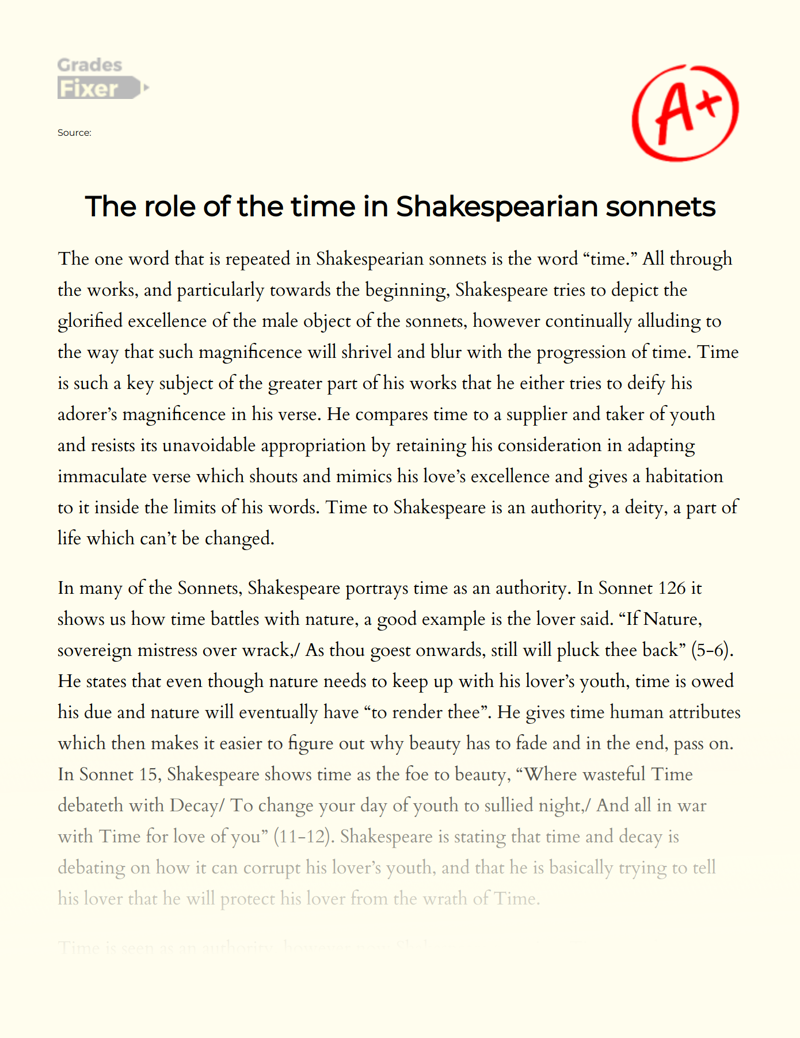
Still can’t find what you need?
Browse our vast selection of original essay samples, each expertly formatted and styled
Related Essays on William Shakespeare
The play, The Tragedy of Hamlet The Prince of Denmark, follows the story of Hamlet after his father’s murder. Hamlet learns that Claudius, his stepfather and uncle, poisoned his brother and his father wants his death to be [...]
In the Shakespearean play, "Macbeth," the witches influence on how Macbeth made his decisions played a crucial part in contributing to his eventual destruction. The witches were trying to create chaos by prophesying to Macbeth [...]
A Shakespearean Tragedy: Enter the world of William Shakespeare's "Hamlet," where ambition, revenge, and tragedy intertwine. Join me as we unravel the intricacies of Hamlet's character and the tragic flaws that lead to [...]
Macbeth, written by William Shakespeare, is a timeless masterpiece that has stood the test of time for over 400 years. This Scottish tragedy, set in the Jacobean society, explores the themes of power, ambition, betrayal, and the [...]
Shakespeare weaves an intricate web ensnaring the characters in The Tragedy of Othello, The Moor of Venice. A handkerchief, a small and seemingly insignificant square of fabric, exerts magical powers over the characters as it [...]
Shakespeare, William. Othello. Edited by Barbara A. Mowat and Paul Werstine, Folger Shakespeare Library, 2009.Bloom, Harold, editor. Othello: Modern Critical Interpretations. Chelsea House, 2001.Greenblatt, Stephen. "Murdering [...]
Related Topics
By clicking “Send”, you agree to our Terms of service and Privacy statement . We will occasionally send you account related emails.
Where do you want us to send this sample?
By clicking “Continue”, you agree to our terms of service and privacy policy.
Be careful. This essay is not unique
This essay was donated by a student and is likely to have been used and submitted before
Download this Sample
Free samples may contain mistakes and not unique parts
Sorry, we could not paraphrase this essay. Our professional writers can rewrite it and get you a unique paper.
Please check your inbox.
We can write you a custom essay that will follow your exact instructions and meet the deadlines. Let's fix your grades together!
Get Your Personalized Essay in 3 Hours or Less!
We use cookies to personalyze your web-site experience. By continuing we’ll assume you board with our cookie policy .
- Instructions Followed To The Letter
- Deadlines Met At Every Stage
- Unique And Plagiarism Free

Shakespeare’s Global Sonnets pp 1–14 Cite as
Shakespeare’s Global Sonnets: An Introduction
- W. Reginald Rampone Jr. 15
- First Online: 23 February 2023
153 Accesses
Part of the book series: Global Shakespeares ((GSH))
This introduction opens with a brief discussion of the history of the composition of sonnets and sonnet sequences in sixteenth and seventeenth century England. It then moves on to discuss the organizational structure of the sonnet sequence and some of the controversies concerning the relationships that the speaker had with the young man and the dark lady. At the same time, I stress the importance of the global impact of the sonnets on countries not only in Europe but also in Asia, whose linguistic system is quite different from an Anglophonic one. The introduction itself is divided into thematically titled sections just like the collection itself: Global Translations: Defining the Nation, Refining Poetics; Sonnets in Performance: Theatre, Music, and Film; and finally, Global Issues in the Sonnets. In each of these sections, I present the organizational structure and the argument of each essay and provide examples by which the contributors support their claims regarding their arguments. Finally, I raise questions regarding how the essays will change how scholars read, study, and teach the sonnets.
- Sonnet sequence
- Shakespeare’s sonnets
- Global Shakespeare
- Global translation
- Sonnets in performance
This is a preview of subscription content, log in via an institution .
Buying options
- Available as PDF
- Read on any device
- Instant download
- Own it forever
- Available as EPUB and PDF
- Compact, lightweight edition
- Dispatched in 3 to 5 business days
- Free shipping worldwide - see info
- Durable hardcover edition
Tax calculation will be finalised at checkout
Purchases are for personal use only
Edmondson, Paul and Stanley Wells, (eds). 2020. All the Sonnets of Shakespeare . Cambridge: Cambridge University Press.
Google Scholar
Garber, Marjorie. 2005. Shakespeare After All. New York: Anchor Books.
Kernan, Alvin. 1995. Shakespeare, the King’s Playwright: Theater in the Stuart Court, 1603–1613. New Haven and London: Yale University Press.
Kerrigan, John. 2006. “Shakespeare’s Poems”. In The Cambridge Companion to Shakespeare , ed. Margreta de Grazia and Stanley Wells, 65–82. Cambridge: Cambridge University Press.
Kingsley-Smith, Jane. 2019. The Afterlife of Shakespeare’s Sonnets . Cambridge: Cambridge University Press.
Shakespeare, William. 1924. Much Ado About Nothing . Ed. Grace R. Trenery. London: Methuen and Co.
Shakespeare, William. 1964. The Sonnets and Narrative Poems: The Complete Non-Dramatic Poetry. Introduction. W. H. Auden. New York: Penguin Group.
Shakespeare, William. 1997. The Norton Shakespeare. 1 st ed. New York: Norton.
Download references
Author information
Authors and affiliations.
Richmond, VA, USA
W. Reginald Rampone Jr.
You can also search for this author in PubMed Google Scholar
Corresponding author
Correspondence to W. Reginald Rampone Jr. .
Editor information
Editors and affiliations.
University of Roehampton, London, UK
Jane Kingsley-Smith
Orangeburg, SC, USA
Rights and permissions
Reprints and permissions

Copyright information
© 2023 The Author(s), under exclusive license to Springer Nature Switzerland AG
About this chapter
Cite this chapter.
Rampone, W.R. (2023). Shakespeare’s Global Sonnets: An Introduction. In: Kingsley-Smith, J., Rampone Jr., W.R. (eds) Shakespeare’s Global Sonnets. Global Shakespeares. Palgrave Macmillan, Cham. https://doi.org/10.1007/978-3-031-09472-9_1
Download citation
DOI : https://doi.org/10.1007/978-3-031-09472-9_1
Published : 23 February 2023
Publisher Name : Palgrave Macmillan, Cham
Print ISBN : 978-3-031-09471-2
Online ISBN : 978-3-031-09472-9
eBook Packages : Literature, Cultural and Media Studies Literature, Cultural and Media Studies (R0)
Share this chapter
Anyone you share the following link with will be able to read this content:
Sorry, a shareable link is not currently available for this article.
Provided by the Springer Nature SharedIt content-sharing initiative
- Publish with us
Policies and ethics
- Find a journal
- Track your research

A Guide To Writing Shakespeare Essays, Including Pitfalls & Tips
William Shakespeare is undoubtedly one of the most significant personalities of the world and culture in particular. This dramatist is considered to be an inventor of literary English language, an inventor of modern theater, and the greatest poet in the history of England. Starting in the 15th century, Shakespeare’s poems and plays have been published in a lot of countries and translated into almost all languages of the world. It is no wonder that students have to write a Shakespeare essay despite their disciplines and specialization. The assignments vary. You might get a task to analyze the sonnets or a play of a famous playwright and writer, write a book report, or say some words about his life in a Shakespeare biography essay. No matter what is your writing about, experts from ProHighGrades collected some ideas and essential tips that will help.
How to Write a Shakespeare Biography Essay
If you are to write essays about the background of a great author, you need to know his biography, and the peculiarities of the time he lived in. Here are some ideas:
- Describe the town he was born and lived. Stratford-upon-Avon was a small English town, and his family was among the noble ones. You can analyze the primal education and the reasons to move to London.
- Literature resources give a little knowledge of young Shakespeare. No one knows the real day of birth. The authors know he was baptized in April. History did not save much about his school or university education. The period which starts in the year 1585 and finishes in 1593 is called “the lost years of Shakespeare.” An excellent attempt to analyze and make suggestions concerning his real life and a search for additional facts will amaze the professors.
- You can analyze the relationship between Shakespeare and other people. Some works and pages contain suggestions about his love, friends, etc. A good Shakespeare biography essay will try to study the stories related to the company surrounding him. Study the writers he mailed.
- Finally, his last years and death are covered in mystery as well. You can try to find a reason why Shakespeare left a big part of his property to his daughter Susanna. Write about a real reason to move back to Stratford.
A good story about a simple man, people to follow him, the political and historical circumstances and terms, the rights of a human of Shakespeare’s society, popular suggestions, and references to his biography from other sources deserve to appear in an excellent Shakespeare essay.
How to Write an Essay About Shakespeare’s Works
Everybody read the author. Students compose tons of writings, where they give information about his collection of works. In order to claim some originality and score free points on exclusiveness, you need to consider many things:
- All the essays about Shakespeare’s literature are written. People wrote about the classic plays after his sonnet or plots. Scholars read, search, and research the significance of his works in almost every paper. You need something contemporary. New plays and interpretations of the texts appear today (for example, a fresh Hamlet play with Benedict Cumberbatch). New movies come from Hollywood and other countries. Take them into account. Many original Shakespeare essay topics are reserved for you
- If you are in despair, choose a way that worked for centuries. Analyze the title of a particular poem or play. A Midsummer Night’s Dream , the plays entitled by names ( Romeo and Juliet , Macbeth , Much Ado About Nothing and others are a reason to write a good, short essay about William Shakespeare.
- A good idea is to analyze the characters of Shakespeare. His plays are not all full of action, but characters are deep. Conflicts, emotions, experience, and background stand behind every one. To make a Shakespeare paper better, reading work is not enough. Try to watch the performance of actors from plays and movies. Usually, they do not make an exact copy of the text but bring the new interpretation.
- Good Shakespeare essay examples choose famous critics for referencing. A catchy quote or a properly referenced idea will make your essay worth money and effort. Remember that the question you ask in the Shakespeare paper must find its answer despite the length of a paper, and a number of essay pages needed.
- Adjust your essay to a discipline. In every Shakespeare text, you can find something for a history, sociology, culture, linguistics, psychology, arts, mythology, and literature essay.
Shakespeare was not a simple person and now has a truly global identity. His impact on his and further times are great. Many people study him, and increasingly significant numbers will no doubt do so in the future. You can also count on the guys from EditProofRead to check out your paper to make sure it’s good.
- Pinterest 0
Leave a Reply
Leave a reply cancel reply.
Your email address will not be published. Required fields are marked *
Save my name, email, and website in this browser for the next time I comment.

- International edition
- Australia edition
- Europe edition

Practice by Rosalind Brown review – tea, yoga and sonnets
The minutiae of a day in the life of a mostly happy student are brilliantly conveyed in this wryly comic debut
T his debut novel follows a day in the life of Annabel, an Oxford student writing an essay about Shakespeare’s sonnets. She wakes and makes tea, works on the essay, meditates, does yoga, works a little more, takes walks, has memories and fantasies, eats in the dining hall, talks to her boyfriend on the phone. The book ends as the day ends. For most of the novel, she’s alone in her room. It is an uneventful day in a safe, cocooned, mostly uneventful life.
The great strength of Practice is Brown’s gift for the romance of the quotidian. Annabel is absorbed by the minutiae of her day: the “building roar” of the electric kettle, the growing pressure in her bladder, her ephemeral lust on seeing lines of muscle sharpening in a passing runner’s calves. She takes pleasure in using the same peppermint teabag twice, “As if there might be something in it she missed the first time around … she enjoys riding the spectrum from what is officially peppermint tea through something more like flavoured, tinged water. To travel in a lonely country most people wouldn’t call tea.”
Brown is just as good when she zooms out to show a complex situation in one sharp, gorgeous paragraph, as in this precis of Annabel’s boyfriend:
Dr. Richard French, 36 years old, general practitioner, he did electives in emergency wards and watched people die on operating tables, he prescribes opiates every day and briskly comforts old ladies, and once in his kitchen he took his stethoscope and slid the cold disc under her bra so she gasped, and he smiled – but he’s afraid of her, ain’t that the truth, he fucks her holding his breath.
The character of the solipsistic, over-earnest, pretentious, self-consciously ascetic Annabel is also brilliantly done. She takes herself too seriously, and knows she’s taking herself too seriously, and takes that too seriously. She takes Shakespeare not only seriously but personally, as only a bookish undergraduate can. Her conception of the love triangle in the sonnets blurs into her own sexual fantasies, then into YA romance tropes before straying on into the weirder outskirts of girlish desire. Like many very young people, she is always performing, just a little bit, for herself.
She is also – unusually for a protagonist of fiction – fundamentally happy. In fact, her happiness, and the fragility of happiness, is a theme of the book. Her Oxford is a place of fabulous serenity and beauty, and she’s an affluent, young, white, healthy person from a happy, loving family. Yes, her boyfriend is too old for her, but he’s thoughtful and patient and devoted. Then there’s her pleasure in solitude and reading, a pleasure so keen it’s sexual. Having trouble finishing her essay might really be Annabel’s worst problem. But others’ problems loom into the frame; the mind seeks out the pain in memory; a quiet idyll can become a place where guilt and anxiety sound very loud.
A novel without events is a stunt, much as a novel consisting of a single sentence is. We expect it to have its own artistic logic, a logic that transcends the usual form of the literary novel: we want less to be more. If Practice has a weakness, it’s that, at heart, it ’ s rather traditional. It builds to a decision with potentially far-reaching consequences for the protagonist, and the decision is not about essay writing, but about erotic love. There is a plot here, it’s just very faint and ambiguous, like Annabel’s peppermint tea.
Brown is a wonderful writer, and she mostly makes this work. But towards the end, I found I didn’t want to read another of Annabel’s sex fantasies, or hear another of her artful pronouncements, and I couldn’t help noticing that the few scenes where she talked to real people or remembered key events were much more interesting than the ones describing her yoga routine. Her ideas about Shakespeare seemed less and less important as the book went on, and I ultimately felt that, if Brown wasn’t going to attempt a Mrs Dalloway or Ulysses, I might have preferred a novel that just told a story in scenes that mattered.
after newsletter promotion
But I’ve always been a person who likes strong tea. So it means something that, despite my fidgeting, I both enjoyed and admired this novel. It was mostly a pleasure to travel in a lonely country most people wouldn’t even call story, to dwell in the satisfactions and strangeness of less when it’s just less.
Most viewed
William Shakespeare’s Sister, Joan, Emerges in Long-Lost Writings
The Shakespeare “Spiritual Testament” has baffled historians for years. Now, it may shed new light on the famous playwright’s mysterious younger sister Joan.
By Marla Mackoul | Mar 31, 2024
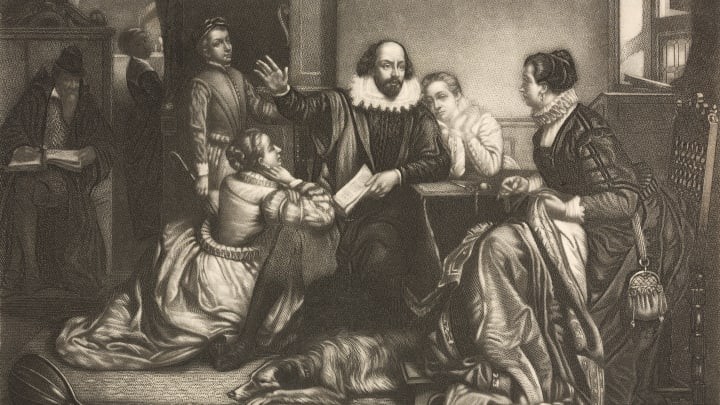
In 1757, nearly 150 years after William Shakespeare ’s death, a pamphlet was found in the rafters of his childhood home. Handwritten and signed by a ‘J. Shakespeare,’ the document was a passionate Catholic profession of faith. It was a promise to die a good Catholic death, understandably hidden in the rafters during a time when the Protestant Church of England was essentially at war with Catholicism. Discovery could’ve meant torture, or even death.
For years, scholars have considered this pamphlet to be the work of John Shakespeare, William’s father, and used it as evidence that the Shakespeare we all know and love was likely raised in a secretly, and perhaps fervently, Catholic household.
But new analysis of the booklet calls all of that into question. Archival research examining a 1790 copy of the document—as the original was, unfortunately, lost—in addition to other texts from Shakespeare’s time shows that it probably wasn’t written by John Shakespeare, as had always been assumed. Rather, it was the work of William’s younger sister, Joan.
“The Last Will and Testament of the Soul”
Researcher and University of Bristol professor Matthew Steggle pieced together timelines using numerous internet archives to prove that the document must be hers. The writing, it turns out, is actually an incomplete translation of “The Last Will and Testament of the Soul,” an Italian text Steggle deduced originated several years after John’s death in 1601. Meanwhile, Joan was the only other J. Shakespeare living during this period. As a simple matter of dates, the pamphlet must have been hers—a shocking revelation that makes it her only surviving piece of writing.
Steggle’s discovery sets the record straight on an important document in Shakespeare family history. It seems we know less about William Shakespeare’s religious life than ever, given that Joan’s ideologies doesn’t necessarily reflect the attitudes of their childhood home. But beyond that, this revelation gives us crucial insight into the mystery of Shakespeare’s sister.
Who Was Joan Shakespeare Hart?
Not much is known about Joan Shakespeare Hart. Born in 1569, five years after the famous bard, she was the only one of William’s seven siblings to survive him. We know that Joan married a hatter, William Hart, had four children, and lived in a cottage on the Shakespeare estate. Her legacy has endured, albeit differently than her brother’s; her descendants are now his most direct living relatives. But we know little about Joan the person and what she was like. The “Spiritual Testament” gives Joan a voice of her own for the first time.
“I, [Joan] Shakespeare, do protest that I will willingly accept of death in whatsoever manner it may befall me, conforming my will unto the will of God,” she writes . “Accepting of the same in satisfaction for my sins and giving thanks unto his divine majesty for the life he hath bestowed upon me.”
She goes on to claim Saint Winifred as a patron saint whom she hopes will comfort her in her last hours, another key indicator that Joan was likely the writer. Saint Winifred’s life story centered around staving off unwanted suitors, making her a particular favorite among women.
“Shakespeare’s Sister”
Steggle himself feels that Joan Shakespeare Hart’s symbolic meaning as William Shakespeare’s sister makes his discovery all the more important:
“There are only seven surviving documents from Joan’s lifetime that even mention her by name. Virginia Woolf wrote a famous essay, “Shakespeare’s Sister,” about how a figure like her could never hope to be a writer or have her writing preserved, so she has become something of a symbol for all the lost voices of early modern women. There are hundreds of thousands of words surviving from her brother, and until now none at all, of any description, from her.”
Women like Joan are largely lost to history , with records proving they existed at best. But Steggle’s findings have turned the tides in this particular case: Joan’s risky dedication to her faith survives hundreds of years later alongside her brother’s plays.
A Remarkable Discovery of a Document Shatters One of Shakespeare's Biggest Mysteries
A secret parchment has resurfaced, rewriting the Bard’s sketchy family history.
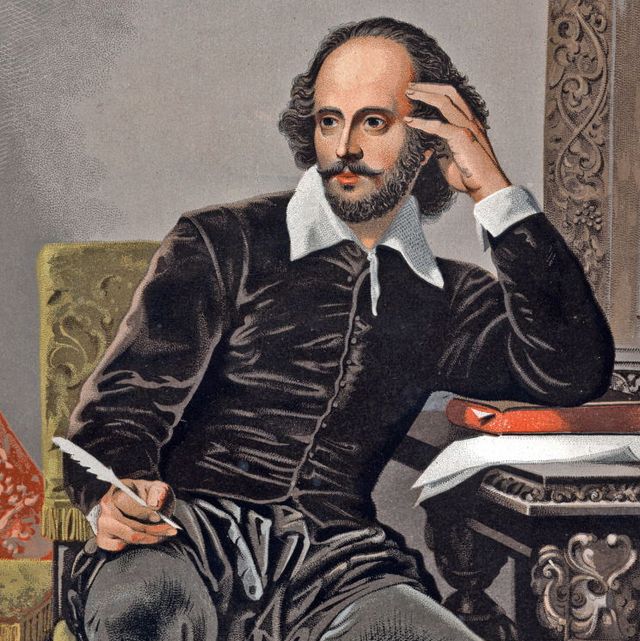
In the annals of William Shakespeare ’s legacy, a twist has emerged that’s practically as dramatic as any of the Bard’s plays: the real “Shakespeare” behind a centuries-old family document has been revealed ... and it’s not the man we expected.
In 1757, a bricklayer found a religious document hidden in the rafters of the Shakespeare House in Stratford-upon-Avon, England. Historians have long attributed the document, which was signed, “ J. Shakespeare ,” to William’s father, John.
But a new study in Shakespeare Quarterly, from scholars at the University of Bristol, claims John wasn’t actually the writer of the scrutinized document. Instead, the researchers say it was William’s relatively unknown younger sister, Joan Shakespeare Hart, who is mentioned by name in only seven surviving documents from her lifetime, study author Matthew Steggle said in a statement :
“Virginia Woolf wrote a famous essay, Shakespeare’s sister , about how a figure like her could never hope to be a writer or have her writing preserved, so she has become something of a symbol for all the lost voices of early modern women. There are hundreds of thousands of works surviving from her brother, and until now, none at all, of any description, from her.”
In the tucked-away document, which heavily cites an obscure 17 th century Italian religious tract called The Last Will and Testament of the Soul, the writer pledges to die a good Catholic death. If the writer was indeed John Shakespeare, who remained a devout Protestant until his death in 1601, it would have indicated a major shift in his beliefs and suggested a clandestine life during an era when secret allegiance to the Catholic Church in Elizabethan England could have been dangerous. For this reason, many experts have suspected the document to be forged.
But in the new study, Steggle used internet archives to track down early editions of The Last Will and Testament of the Soul in Italian and six other languages and concluded the document could have only been written after John Shakespeare’s death. That left Steggle with just one other “J. Shakespeare”: Joan.
Joan, who was five years younger than William, survived for 30 years after her brother’s death, and long resided in the family home where the document was found.
“Even 30 years ago, a researcher approaching a problem like this would have been based in a single big research library, using printed catalogues and even card catalogues to try to find copies of this text,” Steggle said in the statement. “But research libraries have now made many of their resources available digitally, so that it is possible to look across many different libraries in different countries at once, and what’s more, you can look through the whole text, not just at the title and other details.”
Steggle emphasized the importance of this approach in aligning the document’s quotes with the original timing of the composition of The Last Will and Testament of the Soul. Joan, then, who outlived her tradesman husband and had four children in the old Shakespeare family house, had to have been the secret Catholic supporter.
The mystery flourished for centuries, in part, because William Shakespeare himself was a secretive figure, Biography writes .
Shakespeare, who lived from 1564 to 1616, left behind no letters, no handwritten manuscripts, few contemporary accounts, and only six signatures, all spelled differently. It seems almost unbelievable to scholars and critics that the country boy from Stratford-upon-Avon who never attended university wrote 37,000 words for his plays and added roughly 300 words to the English vocabulary.

Yet, the scarcity of Shakespeare’s personal artifacts does little to dim the luster of his legacy, which stands in stark contrast to his modest, mysterious origins.
The early years of Shakespeare’s life are murky. According to Biography , he was born to a father, John, who managed a portfolio as a landowner, moneylender, local official, and glover and leather craftsman. Instead of pursuing higher education, Shakespeare’s knowledge was gleaned from life experiences, absorbing wisdom from his dad’s civic engagements and perhaps gaining insights from his son-in-law, who was a doctor.
The idea that Shakespeare kept his London-based professional life separate from his personal life in Stratford-upon-Avon plays into the recent findings regarding his sister, Joan. “This secretive attitude,” Biography writes, “may have been because much of his family were known Catholic sympathizers and chose to live quietly in Protestant Elizabethan England. In fact, some believe Shakespeare himself received Catholic communion on his death bed.”
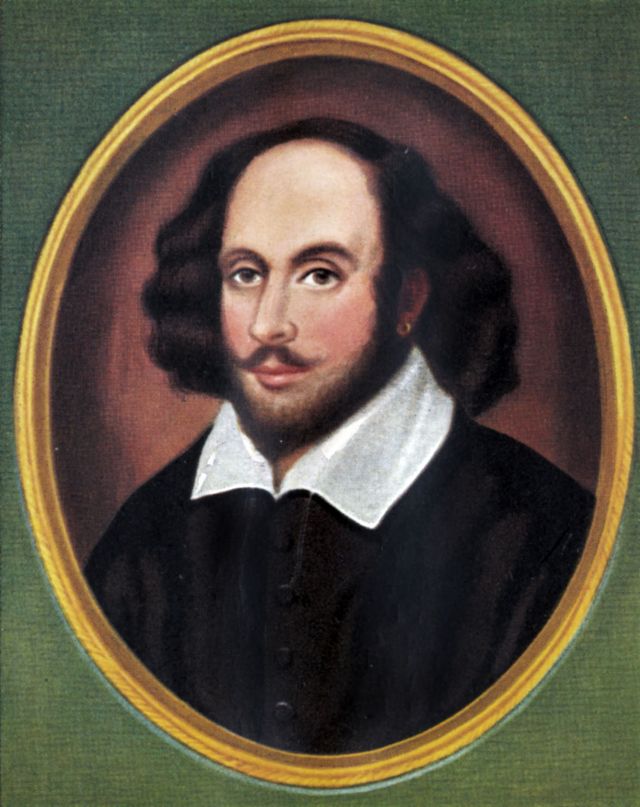
Shakespeare wasn’t known to be loud and boisterous; instead, he carried an air of mystery, relishing the relative anonymity provided by Stratford life. Following his marriage to Anne Hathaway and the birth of their children, there’s a seven-year gap in his historical record. These are known as the “lost years.”
Speculation about William Shakespeare’s “lost years” varies widely; some suggest he may have been in hiding due to accusations of poaching, while more substantiated theories propose he was making a living as an actor and playwright in London. But despite this period of obscurity, Shakespeare’s reputation flourished through his poetry, sonnets, and plays.
As a prominent member of the Lord Chamberlain’s Men, a renowned London acting company, Shakespeare invested in his craft, and his financial success allowed him to buy New Place, one of the largest houses in Stratford-upon-Avon. Shakespeare’s theatrical endeavors didn’t stop there; in collaboration with fellow actors, he started the iconic Globe Theater, which became synonymous with his celebrated playwriting and solidified his legacy.
As Shakespeare grew his name in London’s theaters, he simultaneously established himself as a prominent figure in his hometown of Stratford. Acquiring the family estate in 1601 and subsequently purchasing 107 acres the following year, he strategically invested in additional properties. Experts suggest that the income from leasing these lands gave him the financial stability to pursue his writing.
Meanwhile, Joan resided in the Shakespeare family home amidst speculation and secrets. And its rafters served as a vault for her Italian-inspired religious writings—a hidden gem that’s still sparking scholarly intrigue, and revealing new layers to the Shakespeare legacy today.
Tim Newcomb is a journalist based in the Pacific Northwest. He covers stadiums, sneakers, gear, infrastructure, and more for a variety of publications, including Popular Mechanics. His favorite interviews have included sit-downs with Roger Federer in Switzerland, Kobe Bryant in Los Angeles, and Tinker Hatfield in Portland.

.css-cuqpxl:before{padding-right:0.3125rem;content:'//';display:inline;} Pop Mech Pro .css-xtujxj:before{padding-left:0.3125rem;content:'//';display:inline;}

Homer’s ‘The Iliad’ Poem Leads to Shipwreck Finds

How a Lunar Supercollider Could Upend Physics

The ‘Super Duper Missile’ Has Faded to Black

The Most Expensive Plane Crash in History

Ukraine’s Spies are Flying Black Hawk Helicopters

Air Force Plans for Sixth Gen Fighters, Drones

The US Navy Wants to Get Rid of These Ships ASAP

The Army Is Clearing Out for Coyote Drone Hunters

Can America’s Aging F-16 Overpower Russia’s Su-35?

Could the Chair You Sit on Have a Soul?

The F-35’s Development Road Is Mercifully Over

IMAGES
VIDEO
COMMENTS
The older Petrarchan or Italian sonnet, divided into one octave and one sextet was altered by the English and is named after Shakespeare who used it with such infinite skill. The rhyme scheme of ...
Suggested Essay Topics. 1. Sonnet 18 is one of the most famous poems in the English language. Why do you think this is the case? How does the speaker use natural imagery to create a picture of the young man's beauty? 2. In Sonnet 1, the speaker argues that the only way for the young man to defy the ravaging power of time is to reproduce, but ...
The sonnets were republished in 1640 by John Benson in a form very different from the 1609 collection, including a different order and individually titled poems. The Folger edition of the sonnets, like that of other modern editions, follows the 1609 text. Read and download Shakespeare's Sonnets for free.
Theme Analysis of Shakespeare's Sonnet #29 Anonymous. Shakespeare's Sonnets. This sonnet is narrated by a man whose emotions are completely at the mercy of another. Its theme involves the vulnerability of the narrator's disposition and the power of love. Just when he reaches the lowest point of his depression, the...
Shakespeare transforms the conventional sonnet story by making his beloved a "he.". There is also a female lover in the sonnets, the focus of a secondary relationship treated in many of the last twenty-eight sonnets ( 127 -54). But when attention turns to her, it is not to assert the normality of heterosexual romance.
The Dangers of Lust and Love. In Shakespeare's sonnets, falling in love can have painful emotional and physical consequences. Sonnets 127 - 152, addressed to the so-called dark lady, express a more overtly erotic and physical love than the sonnets addressed to the young man. But many sonnets warn readers about the dangers of lust and love.
Read all 154 of Shakespeare's sonnets. Take your pick from the list of Shakespeare sonnets below (or learn how to write a sonnet of your own!): Sonnet 1: From Fairest Creatures We Desire Increase. Sonnet 2: When Forty Winters Shall Besiege Thy Brow. Sonnet 3: Look In Thy Glass, And Tell The Face Thou Viewest. Sonnet 4: Unthrifty Loveliness ...
Writing an essay on a Shakespearean sonnet can be quite a challenge. The following are a few tips to help you start the process: 1. Find the Theme. Although love is the overarching theme of the sonnets, there are three specific underlying themes: (1) the brevity of life, (2) the transience of beauty, and (3) the trappings of desire.
William Shakespeare (1564-1616) wrote sonnets on a variety of themes. When discussing or referring to Shakespeare's sonnets, it is almost always a reference to the 154 sonnets that were first published all together in a quarto in 1609. However, there are six additional sonnets that Shakespeare wrote and included in the plays Romeo and Juliet, Henry V and Love's Labour's Lost.
The sonnets are written in a distinct form of 14 lines, typically in iambic pentameter, with various rhyme schemes. Ten of the best known of Shakespeare's sonnets are discussed in this SparkNotes guide: Sonnets 1, 18, 60, 73, 94, 97, 116, 129, 130, and 146. The full collection of 154 sonnets are often divided into two main sequences.
Shakespeare's Sonnets: Critical Essays is the essential Sonnets anthology for our time. This important collection focuses exclusively on contemporary criticism of the Sonnets, reprinting three highly influential essays from the past decade and including sixteen original analyses by leading scholars in the field. The contributors' diverse ...
In the sonnet, Shakespeare gives us a wide variety of cues to indicate to us what the speaker is talking about, and what their feelings are. Through almost all of the sonnet the speaker is trying to address the issues of time, and its power. ... Comparative Analysis of the Characters of Macbeth and Lady Macbeth Essay. William Shakespeare was an ...
Essays for Shakespeare's Sonnets. Shakespeare's Sonnets essays are academic essays for citation. These papers were written primarily by students and provide critical analysis of various sonnets by William Shakespeare. Colonial Beauty in Sidney's "Astrophil and Stella" and Shaksespeare's Sonnets; Beauty, As Expressed By Shakespeare's Sonnet 18
This essay on the Sonnet 18 by Shakespeare analyzed the poem's tone, imagery, meaning, and main themes. In summary, the poet is fascinated by his mistress's beauty, such that he cannot imagine that very beauty fading from his eyes. He argues that beauty is constant and, unlike a 'summer day,' is not affected by any changes or fate at all.
In many of the Sonnets, Shakespeare portrays time as an authority. In Sonnet 126 it shows us how time battles with nature, a good example is the lover said. "If Nature, sovereign mistress over wrack,/ As thou goest onwards, still will pluck thee back" (5-6). He states that even though nature needs to keep up with his lover's youth, time ...
Simona Laghi's essay, "Shakespeare's Sonnets in the ELT Classroom: The Paradox of Early Modern Beauty and 21 st Century Social Media," takes up the theme of beauty and colorism, examining how Sonnets 127-130, 131, and 132 "might be the starting point to reflect on the impact that unrealistic digital images disseminated via social ...
A summary of Sonnet 18 in William Shakespeare's Shakespeare's Sonnets. Learn exactly what happened in this chapter, scene, or section of Shakespeare's Sonnets and what it means. Perfect for acing essays, tests, and quizzes, as well as for writing lesson plans.
You might get a task to analyze the sonnets or a play of a famous playwright and writer, write a book report, or say some words about his life in a Shakespeare biography essay. No matter what is your writing about, experts from ProHighGrades collected some ideas and essential tips that will help. How to Write a Shakespeare Biography Essay
While William Shakespeare's reputation is based primarily on his plays, he became famous first as a poet. With the partial exception of the Sonnets (1609), quarried since the early 19th century for autobiographical secrets allegedly encoded in them, the nondramatic writings have traditionally been pushed...
T his debut novel follows a day in the life of Annabel, an Oxford student writing an essay about Shakespeare's sonnets. She wakes and makes tea, works on the essay, meditates, does yoga, works a ...
In 1757, nearly 150 years after William Shakespeare's death, a pamphlet was found in the rafters of his childhood home. Handwritten and signed by a 'J. Shakespeare,' the document was a ...
But despite this period of obscurity, Shakespeare's reputation flourished through his poetry, sonnets, and plays. Related Story 7 People Who Have Confessed to Being D.B. Cooper